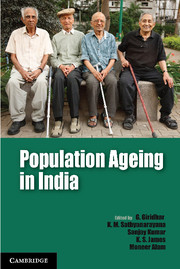Book contents
- Frontmatter
- Contents
- List of Figures
- List of Tables
- Preface
- Acknowledgements
- Introduction
- 1 Demographics of Population Ageing in India
- 2 Elderly Workforce Participation, Wage Differentials and Contribution to Household Income
- 3 Living Arrangements of Elderly in India: Policy and Programmatic Implications
- 4 Health Status of Elderly in India: Trends and Differentials
- 5 The National Policy for Older Persons: Critical Issues in Implementation
- 6 Policy Initiatives on Population Ageing in Select Asian Countries and Their Relevance to the Indian Context
- 7 Studies on Ageing in India: A Review
- Contributors
- Index
Preface
Published online by Cambridge University Press: 05 August 2014
- Frontmatter
- Contents
- List of Figures
- List of Tables
- Preface
- Acknowledgements
- Introduction
- 1 Demographics of Population Ageing in India
- 2 Elderly Workforce Participation, Wage Differentials and Contribution to Household Income
- 3 Living Arrangements of Elderly in India: Policy and Programmatic Implications
- 4 Health Status of Elderly in India: Trends and Differentials
- 5 The National Policy for Older Persons: Critical Issues in Implementation
- 6 Policy Initiatives on Population Ageing in Select Asian Countries and Their Relevance to the Indian Context
- 7 Studies on Ageing in India: A Review
- Contributors
- Index
Summary
Population ageing is one of the most significant demographic trends of the twenty-first century particularly in developing countries of Asia. With the number of elderly progressively increasing in the region, young India is also gradually moving towards an ageing India, as the current youth dividend is expected to last only for less than 10 years. Starting from 2011 there has been a steady increase in old age dependency. According to Census 2011, there are over 100 million senior citizens aged 60 years and above in India. By 2050, this figure is expected to soar to over 315 million. Between 2000 and 2050 the overall population of India is expected to grow by 60 per cent whereas population 60 years and above would grow by a whopping 360 per cent. This huge increase in elderly population is a compelling demographic reality with widespread socioeconomic and cultural consequences that must be factored into national development policies and plans. Targeted investment towards betterment of lives of senior citizens would be needed to ensure that additional years added to lives will indeed be worthwhile for the elderly in particular and for the nation as a whole. This is particularly true for elderly women, who generally live longer than elderly men, and face life-long discrimination. Often referred to as the feminization of ageing, this phenomenon warrants a life cycle view of the ageing process.
- Type
- Chapter
- Information
- Population Ageing in India , pp. xi - xivPublisher: Cambridge University PressPrint publication year: 2014



